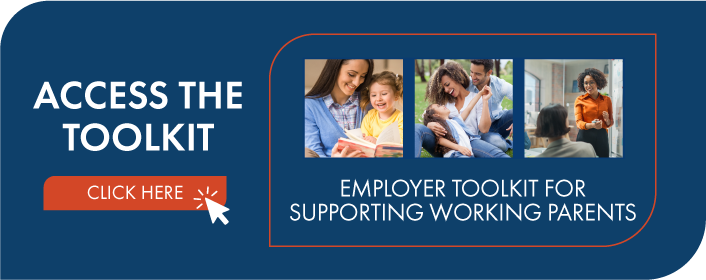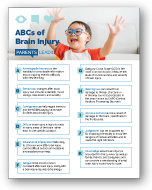Effective options to support working parents
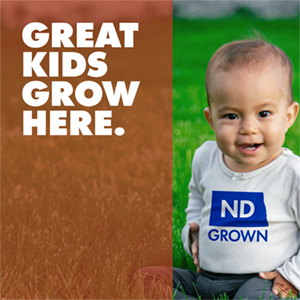
Child Care Assistance Program
This program helps cover the monthly cost of child care for qualifying working families or families in training or education programs by directly paying their child care providers. Note: the program pays providers 10% more when caring for children with special needs.
Working Parents Child Care Relief Pilot Program
This cost-sharing program provides state funds matched with employer child care benefits for families with young children up to three years of age.
Learn more about the Working Parents Child Care Relief Pilot Program
Key workplace supports
Along with offering benefits and providing information about available assistance, there are many different solutions employers can consider to support working parents.
North Dakota Infant Friendly Workplace: Merging Motherhood & Work

WORKPLACE BREASTFEEDING
Lean into a best practice for new moms by making sure your workplace supports breastfeeding moms. Be proactive in sharing your policies on taking breaks at work to pump breast milk and make sure new moms know you have private places set aside for them to pump.
Learn how your business can become an Infant Friendly Workplace

INFANTS IN THE WORKPLACE
After maternity and paternity leave ends, some businesses allow new parents to bring their infants to the workplace.
DEPENDENT CARE FLEXIBLE SPENDING ACCOUNTS
Promote the powerful impact that tax savings can have on employees who run their child care expenses through your company's Flexible Spending Account program.
Other ideas employers can consider

SCHEDULE CONSIDERATIONS
Exploring schedule options for working parents can help ensure parents have reliable child care available when they are scheduled to work. Some working parents may benefit from fixed schedule while others may find that a flexible schedule works better with their child care options. Considering scheduling options can help businesses maintain staffing needs.
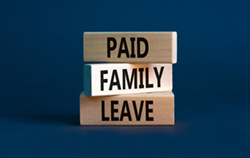
PAID LEAVE
Offer paid family leave as a benefit in addition to annual leave, sick time and holidays.
Backup child care
Provide employees an allowance that they can use for child care when their primary caregiver is temporarily unavailable or their child is sick.

Contracting/collaborating with local providers
Contract with a local child care facility to allocate spots for employees.

Business 10
Provide child care for up to 10 children in the building where parents work. Learn more about starting worksite child care here.
 Care and support
Care and support
Open the door to conversation. Normalize employee discussions about child care considerations.
Where working parents can find quality child care
Parents can search for a licensed, quality early childhood program here. This free online search tool provides customized results based on criteria like location, hours of operation and ages served. This checklist is also a great tool that employees can use when looking for child care.
Personalized help is available through ND’s Child Care Resource and Referral by calling 1-800-997-8515 or by emailing referral@ndchildcare.org.
Supporting working parents of children who have developmental delays
Some working parents have concerns about their child’s development. North Dakota Early Intervention Services can help identify infants and young children (from birth to age three) who have developmental delays at a stage of life when getting the right help can make all the difference. Parents can learn more about Early Intervention Services by contacting a local regional human service center and talking to the Developmental Disabilities team. Regional human service centers can be found at here.
Ready-made content to share with your team!
Begin communicating your company’s dedication to supporting working parents by using this toolkit for writing examples and digital and print materials! Everything in this toolkit is available for you to use as you see best fit for your team's needs.
Emails, intranet, mailings, onboarding packets and more.
[company name] team,
We are excited to announce that we are now offering child care benefits. Eligible employees can now receive up to [amount of total benefit] a month to go towards the cost of child care.
In order to be eligible, you must have at least one child who is under 36 months of age attending a North Dakota licensed child care program and are within the income requirements.
See if you qualify by visiting hhs.nd.gov/wpccr/parents.
If you do qualify, follow these instructions to apply.
Use [your company’s code] for the required employer code in the application.
Please contact [HR rep or company rep name and contact information] if you have any additional questions.
Greetings,
Our company is now participating in North Dakota’s new child care matching benefit program!
What does this mean?
Eligible employees can now receive a state-matched child care benefit of [benefit amount] per month.
Who is eligible?
Any employee who has at least one child under 36 months of age attending a North Dakota licensed child care program.
See if you qualify
Visit hhs.nd.gov/wpccr/parents.
If you do qualify, follow these instructions to apply.
Use [your company’s code] for the required employer code in the application.
Please contact [HR rep or company rep name and contact information] if you have any additional questions.
Social media, intranet, newsletter, onboarding packets and more.
We are proud to announce that our company is participating in the state’s Working Parents Child Care Relief pilot program to help reduce the cost of child care for our valuable and appreciated team members!
[Company name] is excited to begin supporting our team even more by offering child care benefits. Eligible parents can now receive up to [benefit amount] a month to go towards their child care costs.
Images/materials
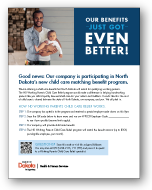 | 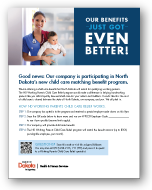 | 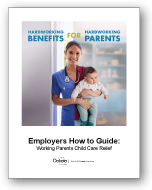 | 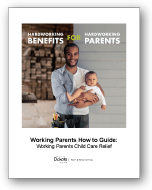 |
1080x1080 (square) graphic  |
Emails, intranet, mailings, etc.
[organization name] team,
We understand the costs of child care and wanted to make sure everyone was aware that help is available through the North Dakota Child Care Assistance Program.
By applying for the program, not only are you saving on child care costs but you are also ensuring that your provider has the resources they need to continue providing care.
Join other North Dakota families who are saving on their child care costs by applying today!
Visit hhs.nd.gov/ccap to learn more and apply.
Good afternoon/morning,
Help with your child care costs is available through the North Dakota Child Care Assistance Program.
Through the program, families may have a portion of their child care costs paid for.
Learn more at hhs.nd.gov/ccap
Social media, intranet, newsletter
Learn how families in North Dakota are saving money on their child care costs. Visit hhs.nd.gov/ccap to see if you qualify for child care assistance. You may be surprised at how much you can save monthly!
Did you know that you could be saving money on your child care costs? Apply for the North Dakota Child Care Assistance Program to not only help you but, to help your provider get the resources they need! hhs.nd.gov/ccap
Images/materials
Child Care Assistance Program (CCAP)
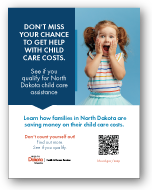 |  | 1080x1080 (square) graphic 
|

| 
| 1080x1080 (square) graphic 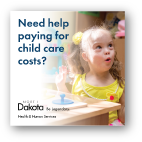 |
Emails, mailing, intranet, onboarding packets and more.
Good morning/afternoon,
We value every member of our team and want to remind everyone that [company] is a designated Infant Friendly Workplace.
Our workplace breastfeeding policy includes:
- A dedicated, private space that is not a restroom for pumping breast milk.
- Flexible break/work scheduling for pumping breast milk.
- Access to a nearby sink and refrigerator.
- And more
You can access our company’s policy at [link to policy]
Please work with your direct supervisor to ensure accommodations meet your needs.
[HR rep name] is also available if you have any other questions or concerns.
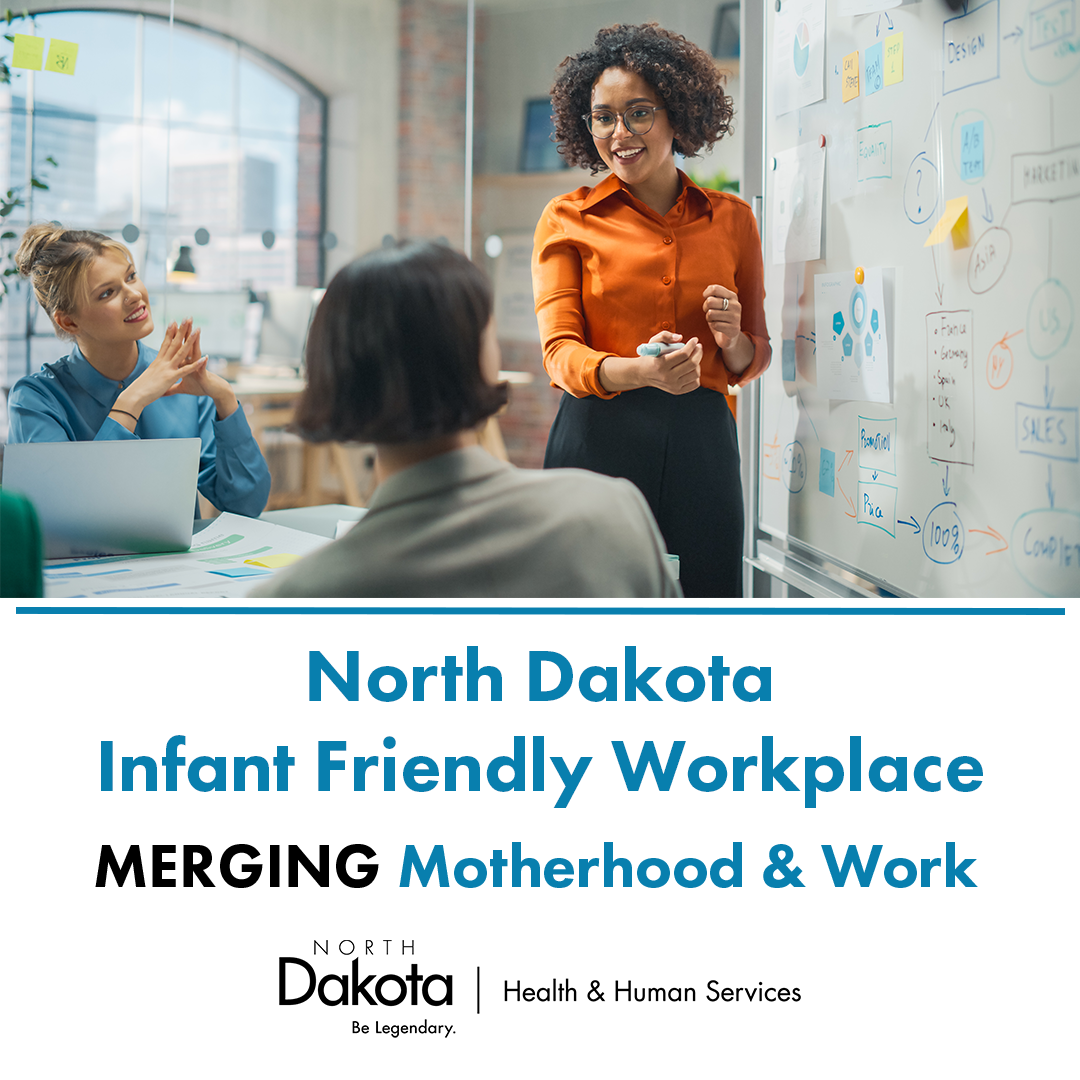
Good morning/afternoon,
If you or a family member are in the process of looking for quality child care, please consider using this free online search tool, which can be accessed at stage.worklifesystems.com/parent/40.
This tool provides customized results based on criteria like location, hours of operation and ages served. Personalized help is available through ND’s Child Care Resource and Referral by calling 1-800-997-8515 or by emailing referral@ndchildcare.org.
Once you find a child care program that fits your needs, make sure to have an in-person visit to talk with the providers and ask for references and records.
Here is an easy-to-follow checklist that you can use to help with choosing the best child care for your child
Are you in the search for quality child care? Check out this free online search tool that provides:
- Customized results based on criteria like location
- Hours of operation
- Ages served
The tool can be accessed at stage.worklifesystems.com/parent/40
When searching for quality child care look for the icon next to the program name to see it's Bright & Early ND quality rating. Bright & Early ND rates early childhood programs across the state based on standards that focus on what children need to learn, grow and develop. The rating system prioritizes safe, healthy, and enriching environments, meaningful learning experiences and well-prepared caregivers.

Step 1: Health and Safety
Step 1 Quality Rated programs are meeting and maintaining child care licensing regulations, this is the foundation of Bright & Early ND. Licensed early childhood programs are required to maintain at least minimum standards related to; physical space, safety features, cleanliness, staff qualifications and staff-to-child ratios. Children need to be healthy and feel safe to learn and grow. It is the first step in preparing children to be ready for school, work, and life.

Step 2: Space and Materials
Step 2 Quality Rated programs are on the path to continuous quality improvement. They continue to meet the requirements of Step 1 and provide a safe, responsive, and engaging environment that sets the stage for optimal early childhood experiences. An intentionally designed environment allows opportunities for children to experiment, practice their skills, analyze, socialize and problem solve. When the environment supports children’s learning and development, they are better prepared for school, work, and life.

Step 3: Activities and Experiences
Step 3 Quality Rated programs continue to meet the requirements of Steps 1 and 2 and provide meaningful activities and experiences that build upon children's strengths and development. Using a curriculum to plan activities and guide teaching practices which align to the North Dakota Early Standards. In addition, they conduct observation-based assessments to ensure children are making progress toward the goals outlined in their curriculum. When children have meaningful experiences, they are better prepared for school, work, and life.

Step 4: Relationships and Interactions
Step 4 Quality Rated programs continue to meet the requirements of Steps 1-3 and foster relationships that support and emphasize children’s interests, motivations, and points of view. All children benefit from being in warm, supportive environments where they can take risks, learn new things, and develop strong relationships with their caregivers and peers. When children experience high-quality interactions, they are better prepared for school, work, and life.
Learn more about Bright & Early ND here.
Personalized help is available through ND’s Child Care Resource and Referral by calling 1-800-997-8515 or by emailing referral@ndchildcare.org.
Quality Care
Share this link with your team to help them learn how child care programs are rated across the state based on specific standards that define quality.
Milestones
Share this resource with your team to help them track their child's milestones.
Brain Building
Share Vroom resources with your team for science-based tips and tools that inspire families to turn shared, everyday moments into Brain Building Moments(R).
Once on the site, parents have the option to create an account to receive customized tips for child's age.
Parents can access Vroom at vroom.org.
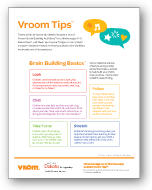
You can also share these materials that cover tips for a variety of ages.
Behavioral Health
Share Parents Lead with parents, so they can find a variety of tools and resources to support them in creating a safe environment for their children that promotes positive behavioral health outcomes.
BOOST YOUR PRODUCTIVITY AND BUSINESS GROWTH:
The value of supporting working parents with child care benefits.
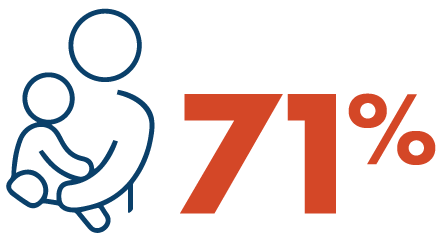
North Dakota employers need help filling open positions. According to a recent North Dakota economic and employer survey, over 70% of respondents stated that issues with child care accessibility and affordability directly impacts an organization’s ability to fully staff its workforce.
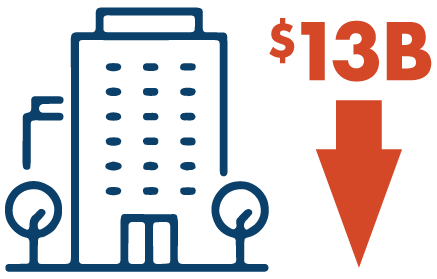
Businesses lose 13B annually in productivity costs due to child care challenges faced by their workforce.
Good for your employees and your bottom line.
Now more than ever, working parents face challenges balancing the demands of work and home. Providing help with child care costs greatly benefits your employees and your business, boosting their productivity and your organization’s profitability. It’s an investment that pays dividends today and into the future. It can be anything from a one-time payment to regular benefits that are paid out monthly.
HOW CHILD CARE BENEFITS BOOST YOUR BUSINESS.
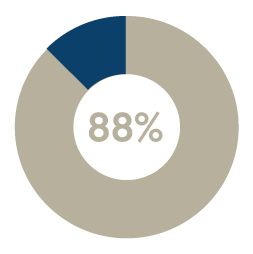
88% of employers report that child care benefits help boost productivity.
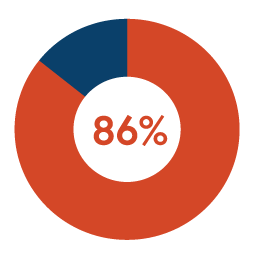
86% of employers say child care benefits have a positive impact on talent recruitment and retention.
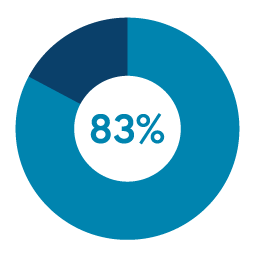
83% of women and 81% of men report child care benefits would be an important factor in deciding to stay at their current employer.
SOURCE: The Best Place for Working Parents Child Care Toolkit


